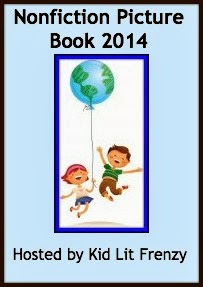
We know that a big part of the CCSS is to include more informational texts into ourstudents' reading. I quickly discovered I had a "gap" in my reading diet - the genre of informational texts! To help me fill the gap this year, I am going to participate in Nonfiction Picture Book Wednesdays! This is a great link-up hosted by Kid Lit Frenzy. Please visit this website to see other educator's link-ups. My goal is to read at least one informational text each week and post information on the blog. The more books and subjects I read, the more I can encourage (my #OLW for 2014) other teachers to use in their classroom!

Tooling Around: Crafty Creatures and the Tools They Use
by Ellen Jackson
What is considered a tool? Some animal scientists define a tool "as an object that an animal uses to accomplish a goal." (pg. 2). How similar are animals to humans? This picture book, perfect for primary classrooms, sets out to inform the reader how animals uses tools to obtain food, attract mates, protect themselves and conceal nests.
Jackson uses rhyming verse on the left side of the page to give a young reader just a bit of information. For example, at the start of the woodpecker finch page the reader finds this, "Finches with a cactus spine dig for bugs on which to dine." (pg. 3) The right side of the page has additional narrative, giving additional information about the way the animal uses the tool and for what purpose.
Many of the animals will be very familiar to young readers, yet others will learn about some new animals. The author also introduces new vocabulary to the readers, for example, "bower", which is a structure the male bowerbird creates in order to attract a female. Is this the same as a "man cave"??? :)
The back of the book has a wide variety of resources. There is an author's note that gives further information about scientists' discussion on if animals are truly smarter than we give them credit for - are they learning about these tools as a result of human intervention, or did they create the use on their own? There is a section titled "Where Do These Crafty Creatures Live?" which gives additional habitat information on each animal presented in the book. Finally, there are lists of resources - books and and websites - that provide additional information.
This is a fantastic book to add for primary classroom libraries. This would be a rich read-aloud that would spark great conversations!
It really does look like a great addition for younger students, Michele. Thanks for sharing it-will show to our librarians!
ReplyDeleteThis book looks like a great one for the younger grades.
ReplyDeleteThis looks wonderful! Must look for it!
ReplyDeleteFascinating! I love apes, and am always intrigued by their brilliance. Thank you for sharing this book.
ReplyDeleteVery interesting - the ability to use tools, evolution, etc are some of the things I teach undergraduate students in our social science class years ago. I can't help but think that this would have been a great read-aloud in one of my lectures.
ReplyDelete